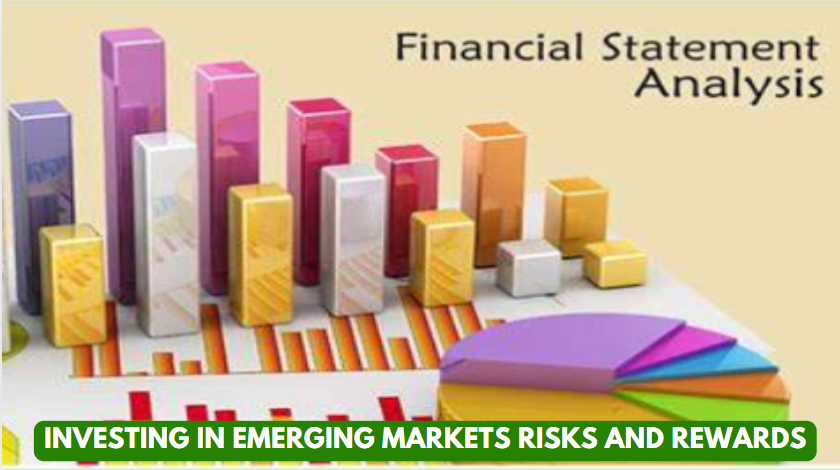No products in the cart.
Stock Market, Stock Market Analysis
Investing and Emerging Market Risks and Rewards 2025
INVESTING IN EMERGING MARKETS RISKS AND REWARDS

Overview
There is potential for both high risk and big profit when investing in emerging markets. These markets offer investors the chance to make substantial profits because of their rapid industrialization and economic expansion. They do, however, also include several difficulties and unknowns that must be carefully considered. The dangers and benefits of investing in emerging markets will be covered in detail in this talk, with a particular emphasis on the Philippines, one of Southeast Asia’s most dynamic economies.
The Temptation of Developing Markets
Emerging markets refer to countries experiencing rapid industrialization, economic development, and integration into the global economy. Nations like the Philippines, Brazil, Russia, India, and China — often known as the BRIC countries — have become magnets for investors seeking higher returns. These markets are typically characterized by:
- Accelerated GDP Growth Rates: Outpacing developed nations due to expanding industries and urbanization.
- Increasing Foreign Direct Investment (FDI): Investors are drawn to these economies due to favorable business climates and untapped opportunities.
- Economic Transformation: Transitioning from agriculture-based economies to industrial and service-oriented sectors.
The allure lies in the potential for high returns as these markets grow, urbanize, and develop new infrastructure. However, along with opportunity comes risk — understanding these dynamics is key for making informed investment decisions.
Philippines’ Economic Growth and Opportunities
Among emerging markets, the Philippines stands out due to its robust economic fundamentals and resilience. The country has shown consistent GDP growth over the past decade, often surpassing global averages. Several factors contribute to the Philippines’ economic momentum:
1. Business Process Outsourcing (BPO): A Global Leader
The Philippines has cemented its reputation as a global powerhouse in the BPO industry. Companies from around the world outsource services such as customer support, IT services, and back-office operations to the Philippines due to its skilled, English-speaking workforce and competitive labor costs. The BPO sector:
- Contributes significantly to national GDP.
- Provides millions of jobs, making it a cornerstone of economic stability.
- Continues to expand, driven by digitalization and demand for remote services.
2. Remittances: A Pillar of Stability
Every year, millions of Overseas Filipino Workers (OFWs) send billions of dollars back home, providing a steady inflow of foreign currency. Remittances play a crucial role in:
- Boosting household incomes, driving consumer spending.
- Supporting sectors like real estate, retail, and education.
- Acting as a buffer during economic downturns, ensuring economic resilience.
3. Tourism: Unlocking Natural and Cultural Wealth
The Philippines is renowned for its stunning beaches, vibrant festivals, and rich cultural heritage. Popular destinations like Boracay, Palawan, and Cebu attract millions of tourists annually. The tourism industry:
- Creates employment in hospitality, transport, and service sectors.
- Encourages infrastructure development to improve accessibility and services.
- Drives growth in local businesses, from resorts to restaurants.
4. Infrastructure Development: Paving the Way for Progress
The government’s ambitious “Build, Build, Build” infrastructure program focuses on developing roads, bridges, airports, and seaports across the nation. This initiative aims to:
- Improve connectivity between regions.
- Reduce logistics costs, making businesses more competitive.
- Attract foreign investments by enhancing infrastructure quality.
These pillars of growth make the Philippines an exciting landscape for investors looking to capitalize on the country’s upward trajectory.
Benefits of Investing in the Philippines
The Philippine investment landscape offers numerous compelling advantages, making it an ideal destination for those seeking long-term growth and diversification:
1. High Growth Potential
With a young and dynamic population, expanding middle class, and rising domestic consumption, the Philippines presents vast growth potential across sectors like:
- Technology: Startups and digital services are booming.
- Real Estate: Demand for residential, commercial, and industrial properties continues to surge.
- Retail: Increasing consumer spending drives expansion in retail and e-commerce.
2. Strategic Location
Situated at the heart of Southeast Asia, the Philippines serves as a gateway to the ASEAN market — a region with over 600 million consumers. Its inclusion in various regional trade agreements gives investors easier access to neighboring markets like Indonesia, Malaysia, and Vietnam. This strategic location enhances trade prospects and strengthens supply chain networks.
3. Favorable Demographics
The Philippines has one of the youngest populations in Asia, with a median age of about 25 years. This demographic advantage:
- Drives demand for goods, services, and housing.
- Provides a large, educated, English-speaking workforce, making it highly attractive for multinational companies seeking talent for global operations.
4. Government Support and Initiatives
The Philippine government actively encourages investment through policies aimed at enhancing the ease of doing business. Notable initiatives include:
- Tax Incentives: Special economic zones offer tax breaks to foreign investors.
- Simplified Processes: Streamlined business registration and licensing procedures.
- Public-Private Partnerships (PPP): Collaborative infrastructure projects designed to attract private investment while improving public services.
These initiatives create a business-friendly environment, reducing entry barriers and offering incentives that enhance investor confidence.
Challenges and Risks to Consider
While the Philippines presents exciting opportunities, investors should also be mindful of challenges:
- Political and Regulatory Risks: Changes in government policies or regulatory frameworks can impact investments.
- Infrastructure Gaps: Despite ongoing projects, logistical challenges remain in some regions.
- Market Volatility: Like other emerging markets, the Philippine stock market can be subject to fluctuations due to global economic conditions.
However, savvy investors who conduct thorough due diligence and adopt long-term perspectives are well-positioned to reap substantial rewards.

Investing in the Philippines: Potential Risks
The Philippines has many potential, but there are also significant risks to be aware of.
Political Instability: Investor confidence and economic stability may be impacted by the political unpredictability that has historically characterized the Philippines. Uncertainties may result from changes in the leadership and policies of the government.
Regulatory Difficulties: Difficulties arising from bureaucracy and regulations may affect investors. It can be difficult to navigate the regulatory environment, even with efforts to streamline operations.
Natural calamities: Typhoons, earthquakes, and volcanic eruptions are among the natural calamities that frequently strike the Philippines. These occurrences may harm infrastructure and cause disruptions to economic activity.
Corruption: In the Philippines, corruption is still a major problem that affects business, raises investor risks, and may result in higher expenses.
Market Volatility: The Philippine stock market is prone to extreme volatility, much like other developing economies. Global and domestic economic shocks have the potential to cause large market swings.
Techniques for Reducing Hazards
To reduce these risks, investors ought to think about the following tactics:
Diversification: Investing in a variety of industries and asset classes can help reduce risk. This strategy makes sure the negative effects of occurrences in one industry are as small as possible.
Due Diligence: It is essential to carry out careful investigation and due diligence. Investors can make more educated judgments if they have a thorough understanding of the local market, the regulatory landscape, and potential dangers.
Local Partnerships: Working together with companies and specialists in the area can yield insightful information and help operations run more smoothly. Local partners can guide you through cultural quirks and the regulatory environment.
Long-Term Perspective: By adopting a long-term perspective, investors can profit from the Philippine economy’s underlying growth potential and weather short-term turbulence.
In summary
Investing in emerging markets like the Philippines offers a unique blend of high-reward potential and considerable risk. As one of Southeast Asia’s fastest-growing economies, the country presents an enticing landscape for investors, driven by robust economic growth, a young and dynamic workforce, and a strategic geographic location that serves as a gateway to Asian markets. Key industries such as Business Process Outsourcing (BPO), tourism, real estate, and infrastructure development continue to fuel this upward trajectory, making the Philippines a hotspot for long-term growth opportunities.
However, along with these promising prospects come significant challenges that investors must carefully navigate. Factors such as political instability, bureaucratic complexities, corruption, and the country’s vulnerability to natural disasters add layers of risk. Additionally, regulatory changes and market volatility require a well-thought-out investment strategy to mitigate potential setbacks.
To thrive in this dynamic market, savvy investors should adopt strategies like:
- Diversification: Spreading investments across different sectors to minimize exposure to industry-specific risks.
- Due Diligence: Conducting thorough research into local market conditions, company fundamentals, and economic indicators.
- Building Local Partnerships: Collaborating with local businesses and advisors to gain insights and navigate regulatory landscapes more effectively.
- Staying Informed: Keeping track of government policies, infrastructure projects, and economic reforms that could impact market conditions.
By balancing caution with ambition, investors can tap into the Philippines’ growth story while managing the complexities of its economic environment. In a world where emerging markets continue to play a pivotal role in shaping global economies, the Philippines stands out as a land of opportunities for those willing to embrace both the risks and the rewards.
Check out the Video for this Blog:
READ MORE RELATED BLOGS!
READ MORE AND SHARE!
TSOK Chronicles: Unleashing Passion, Dedication, and Excellence in 2024
2023 Your Practical Wedding Guide
Investments and Finance Ultimate Guide
If you like this article please share and love my page DIARYNIGRACIA PAGE Questions, suggestions send me at diarynigracia @ gmail (dot) com
You may also follow my Instagram account featuring microliterature #microlit. For more of my artworks, visit DIARYNIGRACIA INSTAGRAM


Peace and love to you.